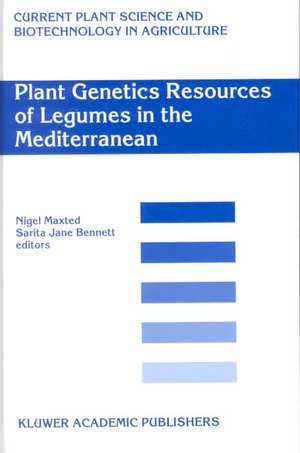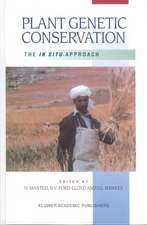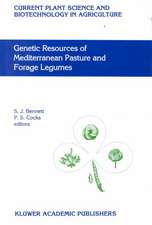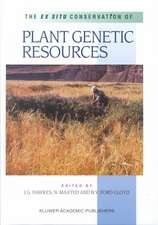Plant Genetic Resources of Legumes in the Mediterranean: Current Plant Science and Biotechnology in Agriculture, cartea 39
Editat de Nigel Maxted, Sarita Jane Bennetten Limba Engleză Hardback – 31 mai 2001
Leguminosae species are of major economic importance (peas, chickpeas, lentils and faba beans, as well as numerous forage species) and provide a particularly rich source of protein for human and animal foods. Their distribution is concentrated in the Mediterranean region and therefore the improvement of their conservation and use in the region is critical.
This text is designed to help ensure an adequate breadth of legume diversity is conserved and to help maximise the use of that conserved diversity. The subjects of conservation and use of legume diversity, the Mediterranean ecosystem and taxonomy of legumes are introduced. Generic reviews of the taxonomy, centre of diversity, ecogeographic distribution, genetic diversity distribution, conservation status, conservation gaps and future research needs are provided, along with a discussion of the importance of rhizobia to the maintenance of legume diversity. Current ex situ and in situ conservation activities as well current legume uses are reviewed. In conclusion future priorities for ex situ and in situ plant genetic conservation and use of Mediterranean legumes are highlighted. All contributors look forward rather than simply reviewing past and current activities and therefore it is hoped that the identification of genetic erosion, location of taxonomic and genetic diversity and promotion of more efficient utilisation of conserved material will be enhanced.
| Toate formatele și edițiile | Preț | Express |
|---|---|---|
| Paperback (1) | 1047.38 lei 38-44 zile | |
| SPRINGER NETHERLANDS – 9 dec 2010 | 1047.38 lei 38-44 zile | |
| Hardback (1) | 1231.78 lei 6-8 săpt. | |
| SPRINGER NETHERLANDS – 31 mai 2001 | 1231.78 lei 6-8 săpt. |
Din seria Current Plant Science and Biotechnology in Agriculture
-
 Preț: 414.14 lei
Preț: 414.14 lei - 18%
 Preț: 1232.57 lei
Preț: 1232.57 lei -
 Preț: 396.78 lei
Preț: 396.78 lei -
 Preț: 396.02 lei
Preț: 396.02 lei - 24%
 Preț: 1602.93 lei
Preț: 1602.93 lei - 18%
 Preț: 1239.19 lei
Preț: 1239.19 lei - 18%
 Preț: 1234.46 lei
Preț: 1234.46 lei - 18%
 Preț: 1228.15 lei
Preț: 1228.15 lei - 18%
 Preț: 1846.58 lei
Preț: 1846.58 lei - 18%
 Preț: 955.40 lei
Preț: 955.40 lei -
 Preț: 450.88 lei
Preț: 450.88 lei - 18%
 Preț: 1228.15 lei
Preț: 1228.15 lei - 24%
 Preț: 1068.10 lei
Preț: 1068.10 lei - 18%
 Preț: 1229.28 lei
Preț: 1229.28 lei - 18%
 Preț: 1842.16 lei
Preț: 1842.16 lei - 18%
 Preț: 949.55 lei
Preț: 949.55 lei - 18%
 Preț: 1848.33 lei
Preț: 1848.33 lei - 18%
 Preț: 950.03 lei
Preț: 950.03 lei - 18%
 Preț: 955.25 lei
Preț: 955.25 lei - 18%
 Preț: 3046.81 lei
Preț: 3046.81 lei - 18%
 Preț: 1842.79 lei
Preț: 1842.79 lei - 18%
 Preț: 1838.38 lei
Preț: 1838.38 lei - 18%
 Preț: 1218.83 lei
Preț: 1218.83 lei - 18%
 Preț: 1243.78 lei
Preț: 1243.78 lei
Preț: 1231.78 lei
Preț vechi: 1502.17 lei
-18% Nou
Puncte Express: 1848
Preț estimativ în valută:
235.70€ • 246.71$ • 196.18£
235.70€ • 246.71$ • 196.18£
Carte tipărită la comandă
Livrare economică 31 martie-14 aprilie
Preluare comenzi: 021 569.72.76
Specificații
ISBN-13: 9780792367079
ISBN-10: 0792367073
Pagini: 380
Ilustrații: XXIII, 380 p.
Dimensiuni: 160 x 240 x 23 mm
Greutate: 0.85 kg
Ediția:2001
Editura: SPRINGER NETHERLANDS
Colecția Springer
Seria Current Plant Science and Biotechnology in Agriculture
Locul publicării:Dordrecht, Netherlands
ISBN-10: 0792367073
Pagini: 380
Ilustrații: XXIII, 380 p.
Dimensiuni: 160 x 240 x 23 mm
Greutate: 0.85 kg
Ediția:2001
Editura: SPRINGER NETHERLANDS
Colecția Springer
Seria Current Plant Science and Biotechnology in Agriculture
Locul publicării:Dordrecht, Netherlands
Public țintă
ResearchCuprins
Section 1 Introduction.- 1 Conservation, Diversity and Use of Mediterranean Legumes.- 2 Ecogeographic Environment of the Mediterranean.- 3 Legume Diversity in the Mediterranean Region.- Section 2 Genetic Diversity of Legumes in the Mediterranean.- 4 Clovers (Trifolium L.).- 5 Medics (Medicago L.).- 6 Chickpeas (Cicer L.).- 7 Lentils (Lens L.).- 8 Vetches (Vicia L.).- 9 Grasspea and Chicklings (Lathyrus L.).- 10 Peas (Pisunr L.).- 11 Lupins (Lupinus L.).- 12 Minor and under-utilised legumes.- 13 Root-nodule Bacteria.- Section 3 Conservation of Legumes in the Mediterranean.- 14 Ex Situ Conservation of Grain Legumes.- 15 Ex Situ Conservation of Forage Legumes.- 16 In Situ Conservation.- Section 4 Utilisation of Legumes in the Mediterranean.- 17 Utilisation of Grain Legume Diversity.- 18 Utilisation of Forage and Pasture Legume Diversity.- Section 5 Afterword.- 19 Future Conservation and Utilisation Priorities.







